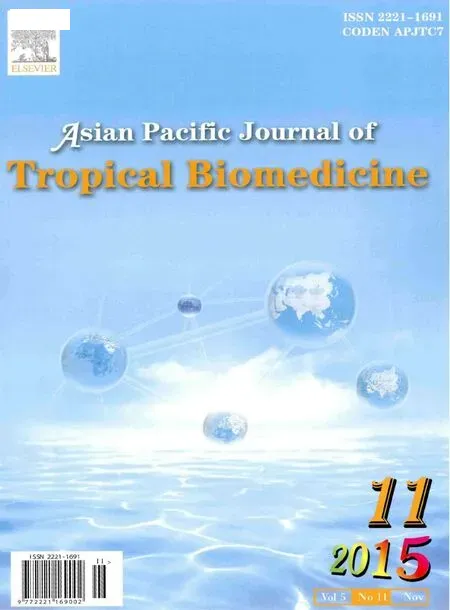Mathematical model explaining iron change in patients with thalassemia
Somsri Wiwanitkit,Viroj Wiwanitkit1Wiwanitkit House,Bangkhae,Bangkok,Thailand
2Hainan Medical College,Haikou,Hainan Province,China
3Faculty of Medicine,University of Nis,Nis,Serbia
4Joseph Ayo Babalola University,Osun State,Nigeria
5Dr.D.Y.Patil Medical University,Navi Mumbai 400706 Maharashtra,India
Mathematical model explaining iron change in patients with thalassemia
Somsri Wiwanitkit1*,Viroj Wiwanitkit2,3,4,5
1Wiwanitkit House,Bangkhae,Bangkok,Thailand
2Hainan Medical College,Haikou,Hainan Province,China
3Faculty of Medicine,University of Nis,Nis,Serbia
4Joseph Ayo Babalola University,Osun State,Nigeria
5Dr.D.Y.Patil Medical University,Navi Mumbai 400706 Maharashtra,India
Letter to the Editorhttp://dx.doi.org/10.1016/j.apjtb.2015.07.017
Dear Editor,
Hemoglobin is an important biochemical pigment seen within erythrocytes.The hemoglobin is the most important content within the red cell.It functions for oxygen carrying,hence,it is very important for human beings.The abnormality of hemoglobin is common in medical practice.The low hemoglobin level from complete blood count is common problem in medicine and it is called anemia.There are many causes of anemia such as iron deficiency disorder and congenital hemoglobin disorders.Thalassemia is a kind of hemoglobin disorder. Thalassemia is due to the inherited abnormality of globin within hemoglobin.The hemoglobin defect resulting in anemia is the feature of thalassemia[1-10].Thalassemia is an important tropical anemia[1-10].The patients affected with thalassemia usuallyhaveabnormalironmetabolismandthe hemochromatosis is very common[1-3].To manage the thalassemic patient is usually difficult.To maintain the normal hemoglobin level is the aim.However,the easily broken red bloodcellisusuallythemainchallengeinclinical management.To support the anemic symptoms of thalassemic patients,transfusionbecomesthewidelyusedmethod. However,the careful consideration is needed before having transfusion therapy used.The transfusion management is usually indicated in cases with severe anemia and this practice can superimpose the severity of hemochromatosis[3].Here,the author tries to assess the physiological change of iron metabolism in patients with thalassemia by using mathematical model technique.The basic pathophysiological and biological processonhemoglobin,iron,ferritinisusedasbasic parameters for mathematical model development.
According to the mathematical modeling,there are some differencesbetweencaseswithandwithouttransfusion(Figures 1 and 2).
In the cases with transfusion,the change of iron can be seen in Figure 3.
The data from these mathematical models can be useful for further study on transfusion practice for thalassemic patients. Indeed,mathematical model is a useful technique for clarifying the complex pathophysiological process.In the present case,the thalassemia,a complex genetic disease,has been studied.It can be helpful for medical scientists to understand the molecular pathology of disease[11].There are extremely few reports on this topic.A previously similar report was conducted by Ginzburg and Rivella[12].In that report,the complex biological process was identified.However,there was still no exact mathematical model study in that report[12].
In conclusion,the authors developed a mathematical model study to help explain the pathophysiological change in thalassemic patients.Effect of standard transfusion therapy is modeled.Also,the in vivo iron distribution is also mathematically studied.With this fundamental mathematical model,the effect of transfusion regiment can be further simulated and studied.
Conflict of interest statement
We declare that we have no conflict of interest.
Acknowledgments
The author would like to thank Professor Massimiliano Cannalire who helped to develop the mathematical model.
[1]Sankaran VG,Weiss MJ.Anemia:progress in molecular mechanisms and therapies.Nat Med 2015;21(3):221-30.
[2]DeLoughery TG.Microcytic anemia.N Engl J Med 2014;371: 1324-31.
[3]Marsella M,Borgna-Pignatti C.Transfusional iron overload and iron chelation therapy in thalassemia major and sickle cell disease. Hematol Oncol Clin North Am 2014;28(4):703-27.
[4]Piel FB,Weatherall DJ.Thea-thalassemias.N Engl J Med 2014;371(20):1908-16.
[5]DeLoughery TG.Microcytic anemia.N Engl J Med 2014;371: 2537.
[6]Yacobovich J,Tamary H.Thalassemia major and sickle cell disease in adolescents and young adults.Acta Haematol 2014;132(3-4): 340-7.
[7]Canatan D.Thalassemias and hemoglobinopathies in Turkey.Hemoglobin 2014;38(5):305-7.
[8]Haddad A,Tyan P,Radwan A,Mallat N,Taher A.β-Thalassemia intermedia:a bird's-eye view.Turk J Haematol 2014;31(1):5-16.
[9]Crielaard BJ,Rivella S.β-Thalassemia and polycythemia vera: targeting chronic stress erythropoiesis.Int J Biochem Cell Biol 2014;51:89-92.
[10]Maakaron JE,Cappellini MD,Taher AT.An update on thalassemia intermedia.J Med Liban 2013;61(3):175-82.
[11]Higgs DR,Gibbons RJ.The molecular basis ofa-thalassemia:a model for understanding human molecular genetics.Hematol Oncol Clin North Am 2010;24(6):1033-54.
[12]Ginzburg Y,Rivella S.β-Thalassemia:a model for elucidating the dynamic regulation of ineffective erythropoiesis and iron metabolism.Blood 2011;118(16):4321-30.
Somsri Wiwanitkit,Wiwanitkit House,Bangkhae,Bangkok,Thailand.
E-mail:somsriwiwan@hotmail.com
Peer review under responsibility of Hainan Medical University.
Article history:
5 Jun 2015
Accepted 5 Jul 2015
Available online 18 Aug 2015
 Asian Pacific Journal of Tropical Biomedicine2015年11期
Asian Pacific Journal of Tropical Biomedicine2015年11期
- Asian Pacific Journal of Tropical Biomedicine的其它文章
- Antibacterial activity of five Peruvian medicinal plants against Pseudomonas aeruginosa
- Oxfendazole as successful treatment of Taenia hydatigena metacestodes in naturally infected pigs
- High resurgence of dengue vector populations after space spraying in an endemic urban area of Thailand:A cluster randomized controlled trial
- Chemical composition and antibacterial activity of essential oil of Launaea lanifera Pau grown in Algerian arid steppes
- A novel HPTLC method for quantitative estimation of biomarkers in polyherbal formulation
- Decreasinga-synuclein aggregation by methanolic extract of Centella asiatica in zebrafish Parkinson's model
